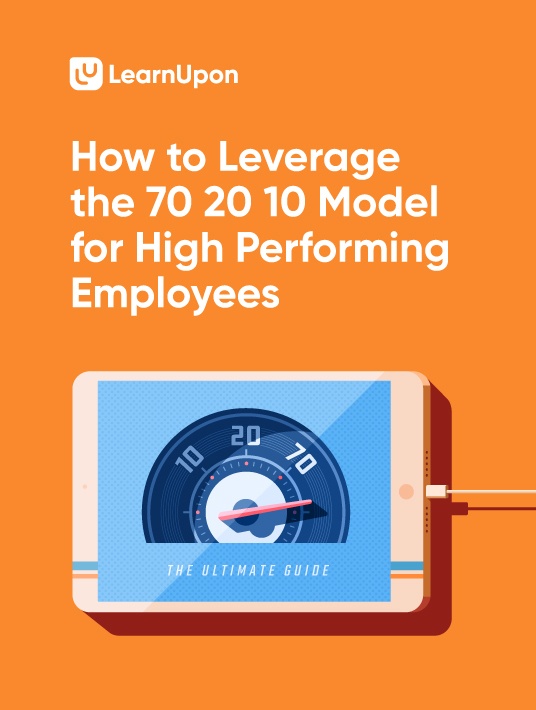Tackling And Overcoming The 70 20 10 Myths
Is this learning model really as straightforward as it seems? Well, at first glance, it is. The theory behind it is simple: when it comes to learning the model states that 70% should happen through doing, 20% through interacting with peers, and 10% through formal training.

Myths surrounding the effectiveness of this approach vary from questioning the breakdown to taking the model too literally. Let's dispel 3 of the most common 70 20 10 myths, namely:
- every professional learns according to 70 20 10,
- the percentages are fixed,
- formal learning isn't worth doing as it's such a small portion of the model.
Every Professional Learns According To 70 20 10
There are lots of ways people learn new information. Some learn better through repetition, others visually, and some hands-on through trial and error.
Many people will have experienced formal learning from their time in school. This learning style doesn't always meet the needs of all learners and schools don't always allow for a blended learning experience. This results in some people struggling to do well during their schooling years. However, as you move into university and beyond, more emphasis is put on group-work and self-directed learning. The 70 20 10 model goes a step further, allowing for a multi-disciplined learning experience, that supports learning in all of its forms.
Experiential learning gives those who learn through doing, a better chance at retaining the information they're acquiring and processing. Learning through peers will suit those who enjoy talking and sharing their ideas and thoughts with others. And, if you have employees who prefer to learn by listening to a subject matter expert or by completing an online course on a given topic, formal learning will work for them.
But the power of the 70 20 10 model is in the cumulative effect of these 3 learning disciplines. Combining experiential, social and formal learning means your employees are far more likely to acquire new knowledge than if they were learning through a single method.
The 70 20 10 Ratios Are Fixed
Those lovely round numbers just seem too good to be true, don't they? Let's be honest: learning can't really be limited to a set checklist or bound by numbers, no matter what the style. Don't get caught up in planning your workforce's learning by matching the exact ratios to the time spent on each. The percentages were never meant to be interpreted in this way. Think of them more as a guideline rather than a rule.
How you manage the breakdown within your corporate learning strategy may also vary depending on the role of each employee. For example, a new hire may learn better in those first few months through formal rather than informal learning. This makes sense as they have to gain knowledge about their role and the organization in a short space of time. They need to quickly get up to speed on what your company does, who's in their team, and what their responsibilities are within their new role. And formal learning is a great way of achieving this.
On the flip side, a more senior member of your team might not need to complete as much formal training. In theory, they already have baseline knowledge, so it's more beneficial for them to focus more on social and experiential learning.
Before you implement the 70 20 10 model, identify how your team currently learns and create your own ratio from that analysis. You could even go a step further and identify ratios for the different roles and seniority levels within your organization. Then use these ratios as a guideline to support your workforce's diverse learning needs.
Formal Learning Isn't Worth Investing In
Formal learning might only be 10%, but that doesn't mean it's not worth investing in or isn't as impactful as the 90%. 70 20 10 is a holistic approach to supporting your workforce's learning and development. Formal training provides baseline knowledge that supports experiential and social learning.
Some may think that only spending 10% of the time on formal learning isn't enough, but this breakdown was never intended to be taken literally. The myth that the 70 20 10 model makes formal learning less of a priority for organizations just isn't true. While there's definitely a greater focus on social and on-the-job learning, it's not meant to be at the expense of formal learning methods. Combining all of these learning styles supports employees in their day to day roles, creates a culture of learning within your organization, and helps to build a high performing workforce.
Stay Informed
We've only covered 3 of the myths surrounding the 70 20 10 model here. While helpful, it's also important to be as informed as possible when selecting a learning model to implement within your corporate learning strategy.
Before implementing it, assess its pros and cons to understand how effective it will be for your employees. By doing this, you'll be better prepared to answer questions and address challenges you may face when you roll it out to your workforce. Download the eBook How To Leverage The 70 20 10 Model For High Performing Employees and get to discover all about the 70 20 10 model, an L&D theory that encapsulates all of the different ways that people learn. Join the available webinar, too, to find out more insightful information about the 70 20 10 model.









